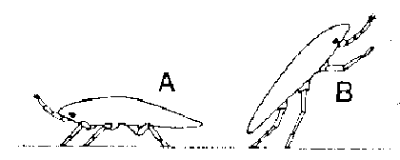 |
Science Frontiers ONLINE No. 33: May-Jun 1984 |
|
|
Prisoners Of The Boundary Layer
Wings were an inspired evolutionary development. They permit the geographical dispersal of many species, especially insects. But nature, ever-innovative, has other aeronautical techniques up her sleeve. Consider the tiniest insects that do not possess wings. It is difficult for large animals like ourselves to realize that these tiny creatures are actually prisoners of the so-called "boundary layer" of air hugging all surfaces. The thin boundary layer is stagnant very close to the surface. Any tiny in-sect wishing to take advantage of wind-dispersal to propagate the species farther afield must somehow breach this layer. Some of the scale insects have in their instar phases developed the trick of rearing up on their hind legs, penetrating the boundary layer, and presenting a high-drag surface to the wind. (Many climb along plant surfaces inside the boundary layer to exposed areas before exhibiting this behavior.) The wind plucks them off the plant and carries them off to new territories. The authors think this may be convergent evolutionary strategy for many minute insects.
(Washburn, Jan O., and Washburn, Libe; "Active Aerial Dispersal of Minute Wingless Arthropods.....," Science, 223:1088, 1984.)
Comment. The fact that these insects are shaped like airfoils (i.e., aircraft wings) is also interesting.
 |
Scale insects (first instar phase). A. In the slow-moving boundary layer. B. Rearing through the boundary layer to present a high-drag cross section to the wind. |